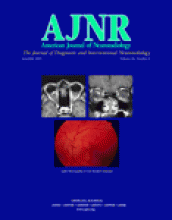Research ArticleBrain
Dilatation of the Virchow-Robin Space Is a Sensitive Indicator of Cerebral Microvascular Disease: Study in Elderly Patients with Dementia
Tufail F. Patankar, Dipayan Mitra, Anoop Varma, Julie Snowden, David Neary and Alan Jackson
American Journal of Neuroradiology June 2005, 26 (6) 1512-1520;
Tufail F. Patankar
Dipayan Mitra
Anoop Varma
Julie Snowden
David Neary

Submit a Response to This Article
Jump to comment:
No eLetters have been published for this article.
In this issue
Advertisement
Tufail F. Patankar, Dipayan Mitra, Anoop Varma, Julie Snowden, David Neary, Alan Jackson
Dilatation of the Virchow-Robin Space Is a Sensitive Indicator of Cerebral Microvascular Disease: Study in Elderly Patients with Dementia
American Journal of Neuroradiology Jun 2005, 26 (6) 1512-1520;
Jump to section
Related Articles
- No related articles found.
Cited By...
- Enlarged Perivascular Spaces are Associated with White Matter Injury, Brain Atrophy, Cognitive Decline and Markers of Inflammation in an Autosomal Dominant Vascular Neurodegenerative Disease (CADASIL)
- Divergent enlarged perivascular spaces volumes in early versus late age-of-onset Alzheimers disease
- On the detectability and accuracy of computational measurements of enlarged perivascular spaces from magnetic resonance images
- Lesion Volume in Relapsing Multiple Sclerosis is Associated with Perivascular Space Enlargement at the Level of the Basal Ganglia
- Physiology and Clinical Relevance of Enlarged Perivascular Spaces in the Aging Brain
- Perivascular Space Semi-Automatic Segmentation (PVSSAS): A Tool for Segmenting, Viewing and Editing Perivascular Spaces
- Characterization of MR Imaging-Visible Perivascular Spaces in the White Matter of Healthy Adolescents at 3T
- Ontario Neurodegenerative Disease Research Initiative (ONDRI): Structural MRI methods & outcome measures
- Altered cognitive function in systemic lupus erythematosus and associations with inflammation and functional and structural brain changes
- Perivascular spaces contribute to cognition beyond other small vessel disease markers
- Perivascular Spaces in Old Age: Assessment, Distribution, and Correlation with White Matter Hyperintensities
- Vascular Cognitive Impairment
- Dilated Perivascular Spaces in the Basal Ganglia Are a Biomarker of Small-Vessel Disease in a Very Elderly Population with Dementia
- Hydrocephalus due to extreme dilation of Virchow-Robin spaces
- Subcortical Cystic Lesions within the Anterior Superior Temporal Gyrus: A Newly Recognized Characteristic Location for Dilated Perivascular Spaces
- Perivascular Spaces Are Associated with Atherosclerosis: An Insight from the Northern Manhattan Study
- Enlarged perivascular spaces as a marker of underlying arteriopathy in intracerebral haemorrhage: a multicentre MRI cohort study
- Rating Method for Dilated Virchow-Robin Spaces on Magnetic Resonance Imaging
- Topography of dilated perivascular spaces in subjects from a memory clinic cohort
- Assessment of the Virchow-Robin Spaces in Alzheimer Disease, Mild Cognitive Impairment, and Normal Aging, Using High-Field MR Imaging
- Frequency and Location of Dilated Virchow-Robin Spaces in Elderly People: A Population-Based 3D MR Imaging Study
- Cerebrovascular Damage in Late-Life Depression Is Associated With Structural and Functional Abnormalities of Subcutaneous Small Arteries
- Enlarged Perivascular Spaces on MRI Are a Feature of Cerebral Small Vessel Disease
- Neuropathological Correlates of Temporal Pole White Matter Hyperintensities in CADASIL
- Biomarkers of cerebrovascular disease in dementia
- Blood Pressure Lowering in PROGRESS (Perindopril Protection Against Recurrent Stroke Study) and White Matter Hyperintensities: Should This Progress Matter to Patients?
This article has not yet been cited by articles in journals that are participating in Crossref Cited-by Linking.
More in this TOC Section
Similar Articles
Advertisement











